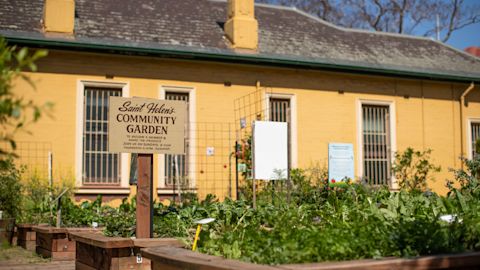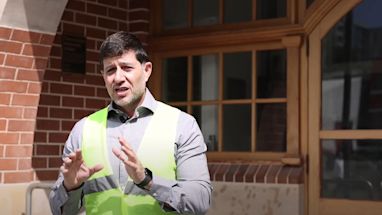From Chippendale to Waterloo, you’ll find more than 20 different community gardens thriving across our city.
We visited 6 of these and talked to the passionate people who tend them.
If you have ideas on how we can best look after community gardens in our local area, take a moment to have your say. We're reviewing our community gardens and composting guidelines and your thoughts will help shape the new policy. Take a moment to complete our online survey.

Chippendale Footpath Sustainable Gardens, Chippendale
In the middle of the city, every scrap of space has value. And Michael Mobbs has made sure that no skerrick of available soil has gone to waste in these footpath gardens. Along the narrow verge between the densely packed terrace houses and the gutter lies an eclectic, free-flowing community garden.
It’s enchanting, unstructured and organic. And because the garden stretches the length of the street and is literally on the residents’ doorsteps, there’s a collective sense of ownership and pride.
“We don’t have members or committee meetings – it’s accessible to everyone,” says Mobbs.
Embedded content: https://youtu.be/CnYqID1HKZc
Michael Mobbs credits the garden with transforming not just the streetscape but the nature of interactions that the street’s residents now have.
“What community gardens mean, are accidental conversations between people who would otherwise remain perfect strangers,” said Mobbs.
“I take my food scraps out, I put them in the compost, which my neighbours use to grow food and feed their families. Gardens grow community; this community is flowering, just like the plants are.”

Bourke Street Park Community Garden, Woolloomooloo
Chook it, and they will come. “This is Holly, our newest member, she’s moved in from Annandale,” said Georgina Bathurst, holding up a healthy-looking Isa Brown her. Her three coop-mates are hard at work scrounging for bugs amongst the snow peas.
“Since we got the chooks in March, membership has doubled.”
Holly clucked quietly at the acknowledgement of her popularity as a rising star of Woolloomooloo.
The Bourke Street Park Community garden was sandwiched, in 2012, into a slither of vacant land beneath the eastern suburbs rail line and the eastern distributor tunnel entrance. It’s loud with the roar of trucks and trains and an unlikely spot for chickens. But that’s a pleasant synonym for community gardens generally – you’ll find them thriving in the most incredible spots.
Embedded content: https://youtu.be/_3SP3ztvpIk
The garden has become more than just a place for growing produce. It’s a hub for community support groups too. Weave Youth and Community services, and the Ozanam Learning Centre have run morning teas and gardening sessions here.
“Today’s the first bubs and carer’s group we’ve hosted,” Bathurst said as she watched a dad trying to juggle a toddler, a dog and a work call. “We really want to see this space used for more than just gardening.”

St Helens Community Garden, Glebe
“This is the engine room of the garden,” Jock Keene said, as he proudly presented 16 compost bins. The term engine room is apt, because the St Helens Community Garden in Glebe is a well-oiled machine.
“We have a series of meetings every season where we go through the catalogues and plan what cultivars we want to plant and then order our organic seeds,” Keene said. “Every Sunday, when we meet, we record what was planted or harvested, and then I write a report for all the members.”
Running this show might sound like a full-time job to some, but to Jock Keene, it’s the perfect retirement project.
“I appreciate the diversity of the community here in Glebe, and that’s reflected in our membership. We have kids, elderly people, people from social housing, every cultural background you can imagine, people with disability.”
Embedded content: https://youtu.be/CgySH1u9LJw
The St Helens Community Garden occupies a truly communal space, slotted into the forecourt between the Glebe community centre and library. “There’s always someone having lunch here. And because it’s a thoroughfare new people are stumbling across the garden all the time,” founding member Jan Macindoe said.
“There’s something nice about knowing exactly where your food has come from,” Nas Pacchlan said, who joined after a chance conversation while enjoying a coffee in the garden.
“And there’s no food miles at all,” Macindoe chimed, “so it’s good for the planet too.”

James Street Reserve, Redfern
As any green thumb will tell you, a garden requires constant attention – weeding, planting, pruning, watering. In a community garden, that commitment is turned up a few notches. Rubbish and sometimes even vandalism are added to the usual challenges of maintenance, Kathy Lindsay said.
“The garden falls into disrepair quickly, but I feel that cleaning it up is my way of contributing to my local community,” Lindsay said.
Lindsay started working in the garden after returning from living in Bangkok, Tokyo, and Jakarta for many years.
“One of the founders of the garden, John Kingston, used to rent our house. When we returned home – and consequently kicked John out – I felt somewhat obliged to ensure John’s handiwork continued to thrive,” she added in jest.

Along with the satisfaction that comes from seeing something grow from seed, there’s the more tangible benefit of being able to eat the fruits of your labour. Sometimes this is especially delicious.
“We’ve got 3 coffee trees here in the garden,” Lindsay said. “Last Christmas we harvested the coffee beans, roasted them, and had enough to make tiramisu for the community Christmas party!”

Charlie’s Garden, Redfern
Some people are passionate about politics. Some are passionate about art or theatre, or food or education. And some, like Judy Ellis, are passionate about soil. Though she doesn’t like to admit it, Ellis is the driving force behind the compact and orderly Charlie’s Garden in Redfern.
Tucked away in small reserve, a stone’s throw from Carriage Works, Charlie’s Garden is cross-generational treasure. Forget the image of a grey-haired gardeners; there are children galore contributing the upkeep of this community garden. Ellis is always looking for ways to get more local kids involved, even planting raspberries and strawberries around the garden’s edge to incentivise inquisitive young berry-pickers.

“We wouldn’t have been able to continue doing what we do without the support from the City,” Ellis said. Recently a City of Sydney grant was used to build a wicking bed, which has reduced the amount of time the community needs to spend watering the crops during hot, dry spells.

Solander Garden, Waterloo
For most kids, food comes wrapped in plastic from the supermarket. But Richard Weeks, who grew up on a farm in southwest NSW, went until late into his teenage years without buying fruit, vegetables or meat from a shop.
Now as manager of community gardens on Waterloo Estate, he’s hoping to pass some of that experience on to the kids and families who live alongside him. The process of educating new gardeners is the real reward for Weeks.
“They think I’m helping them, but really they’re the ones helping me,” he said. “It keeps me young.”

Solander Garden is one of 3 at Waterloo Estate. Resident can apply for their own plot in the garden, and it’s theirs to nurture and enjoy. Excess crops are sold every Friday at the Salvation Army markets across the road.
The experience of Covid-19 brought a new communal activity to the garden – producing hand sanitiser. Aloe vera was harvested and distilled to produce the alcohol for sanitiser which was then distributed free to residents of the estate.
If you'd like to help shape our new community gardens and composting guidelines, take a moment to complete our online survey.
Published 18 October 2020, updated 17 October 2023



